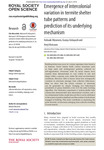Search
Now showing items 21-30 of 144
Emergence of intercolonial variation in termite shelter tube patterns and prediction of its underlying mechanism
(2015)
Building behaviours occur in various organisms from bacteria to humans. Social insects build various structures such as large nests and underground galleries, achieved by self-organization. Structures built by social insects ...
Seasonal changes in the altitudinal distribution of nocturnallymigrating birds during autumnmigration
(2015)
Wind plays a significant role in the flight altitudes selected by nocturnally migrating birds. At mid-latitudes in the Northern Hemisphere, atmospheric conditions are dictated by the polar-front jet stream, whose amplitude ...
Estimating uncertainty and reliability of social network data using Bayesian inference
(2015)
Social network analysis provides a useful lens through which to view the structure of animal societies, and as a result its use is increasingly widespread. One challenge that many studies of animal social networks face is ...
Phenotypic assortment in wild primate networks
(2015)
Individuals’ access to social information can depend on their social network. Homophily—a preference to associate with similar phenotypes—may cause assortment within social networks that could preclude information transfer ...
Receiving of emotional signal of pain from conspecifics in laboratory rats
(2015)
Though recent studies have shown that rodents express emotions with their face, whether emotional expression in rodents has a communicative function between conspecifics is still unclear. Here, we demonstrate the ability ...
Assessing costs of carrying geolocators using feather corticosterone in two species of aerial insectivore
(2015)
Despite benefits of using light-sensitive geolocators to track animal movements and describe patterns of migratory connectivity, concerns have been raised about negative effects of these devices, particularly in small ...
New evidence on the tool assisted hunting exhibited by chimpanzees
(2015)
For anthropologists, meat eating by primates like chimpanzees (Pan troglodytes) warrants examination given the emphasis on hunting in human evolutionary history. As referential models, apes provide insight into the evolution ...
Information use by humans during dynamic route choice in virtual crowd evacuations
(2015)
We conducted a computer-based experiment with over 450 human participants and used a Bayesian model selection approach to explore dynamic exit route choice mechanisms of individuals in simulated crowd evacuations. In ...
Untitled
(2015)
Recent developments in the study of animal cognition and emotion have resulted in the ‘judgement bias’ model of animal welfare. Judgement biases describe the way in which changes in affective state are characterized by ...
Social conformity despite individual preferences for distinctiveness
(2015)
We demonstrate that individual behaviours directed at the attainment of distinctiveness can in fact produce complete social conformity. We thus offer an unexpected generative mechanism for this central social phenomenon. ...










